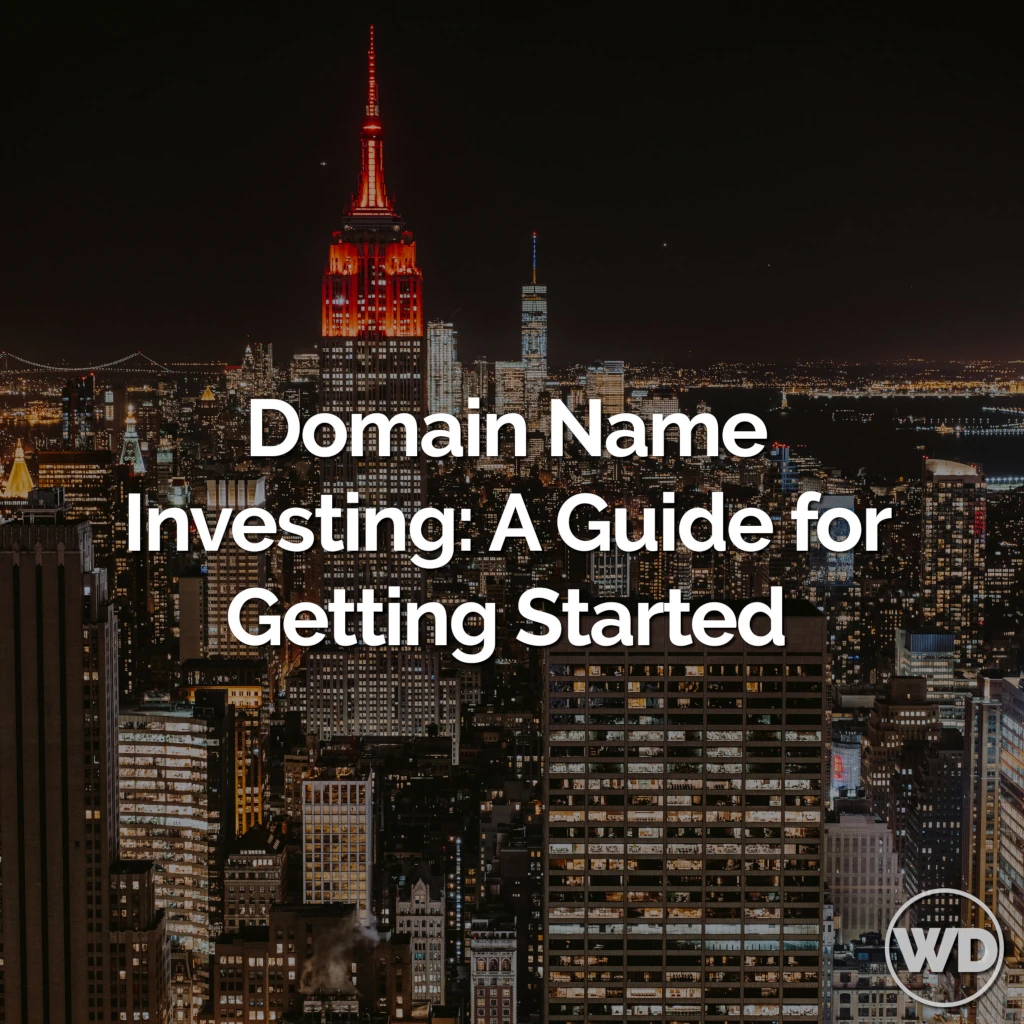An introductory guide for readers interested in buying and selling domain names as investments.
In recent years, domain name investing has become a popular way to generate passive income and build wealth online. The basic idea is simple: buying domain names at a low price and reselling them at a profit. But like any investment, domain name investing requires knowledge, strategy, and a good understanding of market demand. This guide provides an introduction to domain name investing, covering essential steps, tips, and best practices to get you started.
S01-E007
Domain Name Investing: A Guide for Getting Started
Listen to this article as a fast 10-minute podcast.
1. Understanding Domain Name Investing
Domain name investing, also known as domain flipping, involves purchasing domain names and selling them at a higher price to interested buyers. Just as a property investor seeks valuable real estate, a domain investor seeks desirable domain names with high market value. Factors such as length, keywords, TLD (.com, .net, etc.), and memorability can all affect a domain’s resale potential.
Key Reasons for Domain Value:
- Relevance to popular industries (like finance, tech, health)
- Short, memorable, and brandable names
- Keyword-rich domains with high search volume
- High-demand TLDs, like .com
Tip: Not every domain name will be profitable, so research and strategic planning are essential.
2. How to Identify Valuable Domain Names
Identifying valuable domain names requires understanding what makes a domain desirable. Here are the top factors that drive domain value:
a) Short and Simple
Shorter domains (typically under 12 characters) are more valuable because they’re easier to remember and type. A domain like Zoom.com has immense value due to its brevity and ease of use.
b) Keyword Relevance
Domains with high-traffic keywords in popular industries, such as CryptoWallet.com or OnlineLoans.com, are in high demand. Keyword-rich domains are especially valuable when the keywords align with industries that have a high cost-per-click (CPC) in online advertising.
c) Popular TLDs
.com domains hold the most value, followed by .org and .net. While newer TLDs like .app or .io are growing in popularity, .com is still the preferred choice for most buyers due to its credibility.
d) Brandability
A brandable domain name is unique, easy to pronounce, and relevant to the target audience. Examples like BlueBottle or BrightNest are memorable and evoke an image or feeling, increasing their value.
Tip: Use domain appraisal tools like GoDaddy or Estibot to get an estimated value of a domain based on these factors.
3. Getting Started with Domain Investing
Starting with domain investing doesn’t require a massive budget, but it does involve strategic planning. Here are the steps to begin your journey:
Step 1: Research and Understand Market Demand
Before purchasing domains, research popular keywords, emerging trends, and high-growth industries. Tools like Google Trends, SEMrush, and Ahrefs can help you spot high-demand keywords and industry shifts.
Couple of domain resources I use daily:
Step 2: Register a Domain
Once you’ve identified a valuable domain, you can register it through domain registrars like GoDaddy, Namecheap, or Dynadot. The cost of registration typically ranges from $10 to $20 per year, though premium domains (like short, high-demand names) can cost more.
Step 3: Build a Portfolio
Start small by purchasing a few domains to minimize risk, and gradually build a portfolio based on your research and market understanding. A diversified portfolio can include a mix of short domains, keyword-rich names, and trending industry terms.
Tip: Consider quality over quantity. A portfolio of a few high-value domains is often more profitable than dozens of low-value ones.
4. Valuing Your Domain Names
Knowing how to accurately assess the value of a domain is key to successful investing. Here are some valuation factors to consider:
a) Comparable Sales
Check recent sales of similar domains on marketplaces like NameBio to see what similar names have sold for. This will give you a benchmark for pricing.
b) Traffic Potential
Domains with existing organic traffic or search volume tend to be more valuable, as buyers may already see a built-in audience or customer base.
c) Brand Potential
Unique, catchy, and brandable domains tend to attract higher bids, as businesses are willing to pay a premium for names that align with their brand identity.
Tip: Avoid overvaluing your domain based solely on personal preferences; rely on comparable sales and market data to set realistic prices.
5. How to Sell Domain Names
Once you’ve acquired valuable domains, the next step is finding buyers. There are various ways to sell domain names, from online marketplaces to direct outreach:
a) List on Domain Marketplaces
Online marketplaces like GoDaddy Auctions, Sedo, Flippa, and Afternic are popular platforms for listing domains. These sites attract a wide audience of potential buyers and provide tools for setting auction formats, “Buy Now” prices, or negotiating directly with buyers.
b) Use Domain Brokers
If you have high-value domains, you may consider working with a domain broker. Brokers have industry connections and experience negotiating sales, often resulting in higher prices. They typically charge a commission, so this is best for premium domains.
c) Approach Potential Buyers Directly
For highly specific domains, you may identify potential buyers through direct outreach. Sometimes called Outbounding. For example, if you own a domain related to a niche industry, you can reach out to companies in that space to gauge interest.
Tip: When pricing domains for sale, set a fair market price, as buyers are often put off by overly high asking prices.
6. Trends and Strategies for Success in Domain Investing
The domain market is dynamic, so staying aware of trends and adapting your strategy is crucial for long-term success. Here are some strategies to keep in mind:
a) Focus on Emerging Trends
Keep an eye on rising industries and trends, such as AI, crypto, health tech, and sustainability. Domains related to emerging technologies or industries are often valuable as more companies enter these spaces.
b) Consider New gTLDs (Generic Top-Level Domains)
While .com remains the gold standard, certain industries favor specific TLDs like .io for tech startups or .ai for artificial intelligence. Including relevant gTLDs in your portfolio can provide diversification and appeal to niche markets.
c) Leverage Expiring Domains
Many valuable domains expire each day. Services like ExpiredDomains.net and DropCatch help investors track expiring domains that can be purchased for registration fees. Sometimes, you can find valuable domains with existing backlinks and search authority.
Tip: Don’t just buy domains based on hype; focus on names that offer long-term relevance.
7. Calculating ROI and Minimizing Risk
Understanding your return on investment (ROI) is essential to evaluating your success as a domain investor. Keep track of initial purchase costs, renewal fees, and any sales commissions to determine your profit margins. Here’s how to maximize ROI and minimize risks:
a) Set a Budget
Set a clear budget for domain purchases and stick to it. Consider renewal fees, especially if you’re holding domains for a long period, and avoid buying more domains than you can realistically sell.
b) Be Patient
Domain investing is not a quick flip strategy—most domains will take time to sell. Be prepared to hold domains for months or even years to secure the best price.
c) Focus on Market-Driven Value
Avoid basing domain purchases on personal interests. Instead, focus on names that align with market demand and buyer trends, as these are more likely to generate profits.
Tip: Set up a portfolio tracker to monitor performance over time, tracking sales and any trends in value changes.
8. Common Mistakes to Avoid as a Beginner
There are several pitfalls that beginner investors should be aware of to avoid unnecessary losses:
- Overpaying for a Domain: High-value domains come at a premium, but beginners sometimes overpay without adequate research. Always check comparable sales.
- Buying Too Many Domains at Once: Start with a small portfolio to minimize risk. It’s better to focus on a few high-quality domains than accumulate a large inventory of low-value ones.
- Ignoring Renewal Costs: Domains require yearly renewals, so avoid purchasing domains that may be difficult to sell within a reasonable timeframe.
Tip: Avoid emotional buying; every domain purchase should be backed by research and market relevance.
Conclusion
Domain name investing can be a profitable venture with the right strategy, patience, and market understanding. By focusing on quality, staying aware of market trends, and using reputable sales channels, you can build a valuable domain portfolio that yields long-term returns. While domain investing isn’t without risks, with the right approach, it can provide a rewarding side income or even a full-time business opportunity.
Starting small, learning from experience, and leveraging market data will help you become a savvy domain investor with the skills to thrive in this unique investment space.
This guide offers a thorough introduction to domain investing, helping readers understand the process, pitfalls, and best practices.






5 responses to “Domain Name Investing: A Guide for Getting Started Today”
Excellent guide! I’ve been curious about domain name investing but wasn’t sure where to start. Your step-by-step approach and tips for spotting valuable domains were really helpful. I feel a lot more confident diving into this world now—thanks for the insights!
Great article! I appreciate the beginner-friendly approach to a topic that can feel overwhelming at first. Knowing what to look for in a valuable domain and understanding the basics of resale really gave me a good starting point. Thanks for making it accessible!
Priya, we have tried to keep the material simple and straightforward. So glad you liked it. Feel free to get in touch with any questions.
Thanks for this informative post! I didn’t realize domain investing had so many nuances. Your tips on assessing domain value and the importance of niche targeting were super insightful. Looking forward to more content on this topic as I learn the ropes!
Thanks Michael. The content is still a little thin. Watch this post in the coming weeks, we are going to add a ton of new functionality RE domain names and domain name investing.